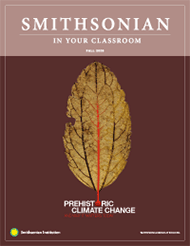
If you’re looking for a science activity to help introduce environmental issues, or if you’re looking for fun and challenging real-world math problems, we invite you to take a look at this issue of Smithsonian in Your Classroom. In the lesson plan, the class does the work of a team of paleontologists studying a time of rapid global warming 55 million years ago. By examining fossils of leaves from various tree species, and by incorporating the findings into a mathematical formula, the students are able to tell average annual temperatures during this prehistoric time.
The method they practice is called “leaf-margin analysis,” which begins by determining the percentage of leaves that have smooth edges, as opposed to toothed, or jagged, edges. This number—the percentage—goes into an equation that gives the average temperature in Celsius. The higher the percentage of smooth leaves, the warmer the climate.
The leaf fossils were discovered by a Smithsonian paleontologist in the Bighorn Basin of Wyoming. It was a major find: the leaves were the first record of plant life from the rapid warm-up, called the Paleocene-Eocene Thermal Maximum (PETM). They showed, more clearly than any other fossils, the dramatic changes undergone by living things during a change of climate.
The PETM has taken on a topicality in recent years. It has been established that the warming resulted from releases of carbon dioxide comparable to human-generated releases in our time. Climate scientists have been turning to PETM experts for an understanding of what our own future might hold.
|
 |
 |
 |
 |

Smithsonian in Your Classroom is produced by the Smithsonian Center for Education and Museum Studies. Teachers may duplicate the materials for educational purposes.
|
 |
 |
 |
|

